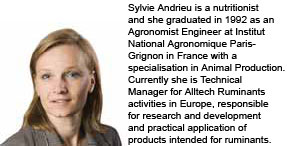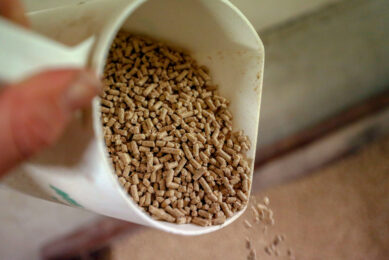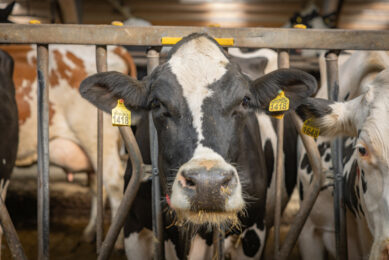Optimising rumen function for cow health

The rumen of the dairy cow is the main site of digestion and provides the energy from microbial fermentation that she needs to maintain pregnancy and lactation, as well as her own body reserves. Additives have a responsible role in this.
By Sylvie Andrieu
The energy balance of a cow determines its metabolic activity and is a key determinant of milk production and fertility. When a cow is in negative energy balance, its metabolic status is impaired, leading to low reproductive performance.
The transition and early lactation periods have been identified as the times when a cow is at most risk of being in negative energy balance. The genetic improvements in milk yield that have been made over the past 50 years are thought to be associated with decreased fertility in dairy cows due to higher metabolic demand (Butler and Smith, 1989). The advent of calving and preparation for lactation, coupled with the typically lower dry matter intakes, causes negative energy balance within the body and an increased rate of mobilisation of body reserves. Cows that have been overfed prior to calving may experience a greater drop in intakes, leading to a more severe negative energy balance (Rukkwamsuk et al., 1999). Such an imbalance can lead to an increase in days to first ovulation post-partum and poor conception rates, due to metabolic changes focused in the liver. When in negative energy balance, the body responds accordingly and fatty acids are mobilised and transformed into energy sources in the liver. In case liver capacity for lipid mobilisation is exceeded, these fats accumulate, causing fatty liver syndrome, lower milk production, impaired immunity and ketosis, as well as interfering with hormone production and return to oestrus. Feeding strategies have been explored that aim to improve the energy provided from rumen fermentation in the transition and early lactation periods in order to limit such metabolic changes and fatty acid mobilisation, in an attempt to reduce the problems associated with fertility and improving milk yield.
Use of live yeastIncreasingly, farmers have applied by-pass nutrients, such as fat in the diet to maintain good performance in the animals. These forms of protected fat can escape rumen degradation without affecting rumen microflora activity and pass into the small intestine, where they are digested and used as an extra energy source.
However, such forms of nutrients come at a price and alternative feed ingredients are available that approach the problem from the other end of the spectrum – by naturally optimising rumen function before using the by-pass nutrients possibility to support milk production. These supplements maintain correct rumen bacteria profiles, thereby boosting fermentation and energy production, giving the dairy cow the nutrient supply she needs for optimal production without the need for expensive forms of by-pass fat in the diet.
Live yeasts are active towards certain groups of rumen bacteria, in particular, stimulating lactate-utilising bacteria activity, resulting in less lactate in the rumen overall and a lower risk of acidosis.
Trial to boost rumen function
In a trial conducted in Estonia, using a live yeast product* to boost rumen function, it has been demonstrated for the first time that pre-partum supplementation has an impact, not only on milk production as it has been widely proven already (Table 1, Figure 1) but also on reducing the negative energy balance situation as shown by a lower circulating non-esterified fatty acids (NEFA) level. The cows fed the yeast supplement had significantly lower levels, indicating a lower requirement for mobilisation of body reserves and thereby improved liver function, associated with a lower risk of ketosis.
When cows were monitored for fertility parameters, cows on the live yeast had their first ovulation after calving six days earlier than the unsupplemented cows.
A further study, conducted in Ireland with cows in early lactation and thus in negative energy balance, showed that these improvements were linked again to reduced days to first ovulation. When rumen function was monitored using an in-sacco method, increased fibre degradation was demonstrated (Table 2) showing that supplemented cows were better able to extract energy from their diet through more intense rumen fermentations. In addition, the cows receiving the live yeast supplementation showed lower circulating NEFA, beta-hydroxybutyrate and the enzyme gamma-glutamate transferase. The latter reflects a nutritional situation resulting in less stress and damage to the liver during the transition, parturition and early lactation phases.
Conclusions
In summary, maintaining adequate energy levels in transition, calving and early lactation periods in dairy cows is essential to maintain milk yields and quality, body nutrient reserves, liver function and return to oestrus. Adding extra dietary by-pass nutrients can be a solution but this has to be done only when optimal rumen fermentations are achieved as this is an affordable and efficient way of providing extra energy to the dairy cow. Trials carried out with the live yeast supplement have shown that this supplement helps maintain correct rumen function and microbial balance, resulting in greater fibre degradation and energy (as well as other nutrient) release. As a feeding strategy, live yeast increases nutrients extracted from the dairy ration through optimal rumen function and is of particular importance at times during which this declines.
As such, it helps to reduce the risk of a cow being in severe negative energy balance thereby reducing the problem of excessive fat mobilisation from body reserves and the associated liver dysfunction. The result is a faster return to oestrus post-calving and increased rates of first conception.
*Yea-Sacc1026
Source: FeedMix vol 17 nr 5, 2009











